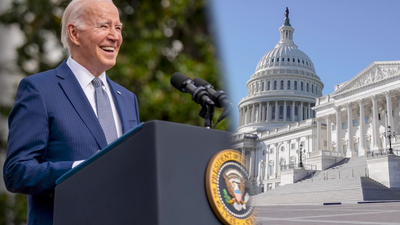
SACRAMENTO, Calif. (KGET) -- Discussions on securing the Latino vote often took center stage at the California Democratic Party's statewide endorsing convention over the weekend.
While the party gathering was about endorsing candidates for 2024, the question of who can get Latino voters out the polls again called for strategizing, even from the state's top Democratic leaders.
And it will again be a race between Republicans and Democrats.
"There's no re-election for Biden and Vice President Harris without Latinos," said panelist Sergio Gonzales, who is the senior adviser for the Biden-Harris campaign.
At that Cafecito VOTA panel, for instance, moderator Ada Briceño raised the question, "Why [is] the Republican Party vying so hard for our vote this election cycle?"
To which Gonzales responded, "Well they certainly know the political and understand the political power of our community."
Party leaders and political experts say the fate of the White House and House of Representatives in 2024 are in the hands of Latino voters.
"We know that right now in the Central Valley in California, that we have some seats that actually should be Democrat that a Republican has," said Dolores Huerta, president and founder of the Dolores Huerta Foundation. "But we know that the Republican Party in the Congress are not doing a good job."
One of those seats Democrats want to flip blue is Congressional District 22, held by Congressman David Valadao (R-Hanford).
The district is primarily Latino and Democratic.
Chair of the California Democratic Rusty Hicks also called Valadao's seat a key target, hinting it will once again be a tight congressional race.
"In the Central Valley what we're seeing is that these races are going to be called based on the Latino vote, and primarily the young Latino vote," CADEM Organizing Director Cassandra Chavez.
Chavez said younger voters care about the environment, abortion and student loans, which are different priorities than the older age groups.
Chavez said generally, the economy and cost of living, housing and healthcare, in that order, are of concern.
"We had to meet voters where they were, because we had to hit every door and go door to door communicating with our Latino community, said California Assemblymember Sabrina Cervantes (D-Riverside). "We had to share a message of inclusivity and making sure they know how politics and government affects their everyday life."
The Latino voter base is a big part of both California and the Central Valley population, but Latinos tend to vote at lower rates.
So remains the challenge often repeated in election cycles -- how do lawmakers get Latinos to vote?
CADEM Vice Chair David Campos said campaigns must "put money where your mouth is" and that the California Democratic Party is doing just that, making big investments.
Advertisements are one element of communication, and party leaders said "microtargeting" to reach voters where they are is becoming increasingly utilized.
"Now we have ran eight different TV ads and two different radio ads with millions of dollars behind those ads," Gonzales said. "So that's top line. [And] running both in English and in Spanish, running on platforms where Latinos are."
Targeting younger voters, who, according to Chavez, typically go for "No Party Preference," has been about digital outreach.
But labor rights activist Dolores Huerta said party identification is important, as "Democrats have been much more progressive when it comes to immigration issues, to women's rights issues."
According to the panelists, Democrats are also pushing its own delegates to share their personal experiences with the party on "earned media" like radio.
And they add seeing Latino candidates run for office can boost voter turnout.
"They see that they will finally have a seat at the decision-making table," said Assemblymember Cervantes.
And specific to that in the Central Valley, Huerta noted, "Many Latinos vote for David Valadao because his last name sounds like a Latino last name. And they don't realize he's Portuguese."
Local demographer statistician Jesus Garcia pointed 17 News to data from L2, an independent voter data and technology firm.
According to that data, which Garcia helped analyze, Latinos make up over half of Kern's total population and over 40% of registered voters.
More specifically, based on data from the 2022 election, Kern is home to nearly 430,000 registered voters. There are over 180,000 registered Latino voters.
In California there are around 6.5 million registered Latino voters.
Jesus Garcia mentioned in general, Latinos lead busy lives, and immigrants from other countries are not so used to the democratic process of voting in the first place.
"Why should they care?" he noted. He said candidates must see their voters in person, care about what the voters care about -- and not just before the election.
One key demographic within the general Latino voter base is Latina voters.
"It doesn't just mean one vote," said Julissa Gomez board president of Latinas Lead. "[Latinas are] gonna mobilize their entire household to go out and vote. They're gonna bring out their kids, they're gonna bring out their mothers."
The panelists also highlighted how the party handles issues like abortion, increasingly relevant to young Latinas, could help secure the community as lifelong voters.
Said Chair of the Democratic Party of Orange County Ada Briceno: "As goes California, so does the nation, folks. So, we here as delegates are an example for what we can have across our country, and what we can do.